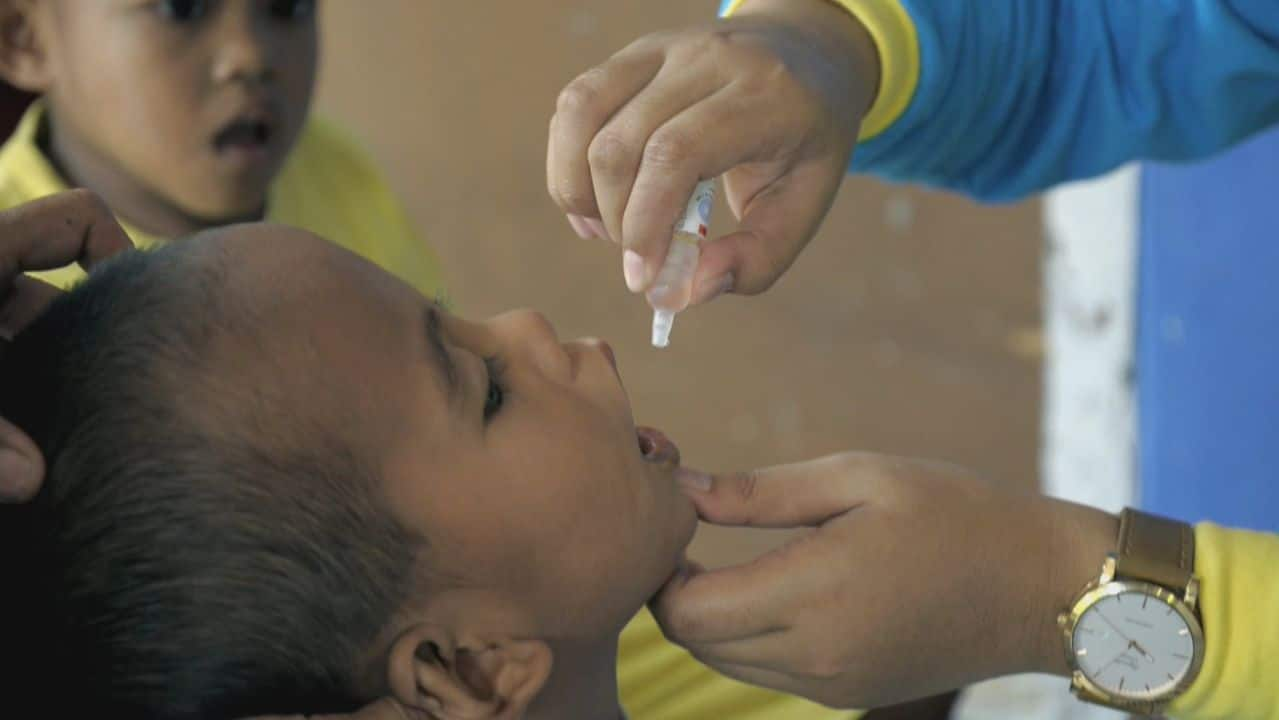Up to date vaccination records are key to preventing outbreaks, says associate professor and researcher.

After routine childhood vaccinations fell during the pandemic, public health officials across the country are working to get Canadian students back up to date on immunizations for serious yet preventable diseases.
In southwestern Ontario’s Waterloo region alone, public health officials said they sent letters to the families of 32,000 elementary and secondary school students, about a third of pupils in the region’s public and Catholic schools, notifying them that they are at risk of suspension over incomplete immunization records for preventable diseases like measles, chickenpox and whooping cough.
When public health staff introduced COVID-19 testing and vaccinations during the pandemic in 2020, routine immunization programs for students across the country fell behind, according to a 2021 study. As well, 19 to Zero, a not-for-profit coalition of medical and public health experts that facilitates vaccination, conducted a national survey in fall 2021 that pointed to 300,000 children who missed or delayed routine immunizations.
When large numbers of kids are missing the protection vaccination provides, the outcome can be deadly, public health experts say.
Shannon MacDonald, an associate professor of nursing at the University of Alberta in Edmonton, co-authored the 2021 study as part of her research into supporting immunization best practices.
Meningococcal infection is one example of a disease that is preventable through routine vaccinations. MacDonald called meningococcus a disease that can kill children, youth and young adults.
MacDonald and her team found immunization among adolescents in Alberta for meningococcal coverage fell from nearly 87 per cent in the 2017-18 school year to about 55 per cent at the height of pandemic school closures in 2020-21.
MacDonald says that since schools are places where kids gather for much of the day, it’s critical that public health knows who is and isn’t vaccinated in case of an outbreak. That’s when it’s common practice for provinces and territories to keep vulnerable, unvaccinated students out of school.
“If you have low vaccine coverage in a school setting, all it really takes is … one case of meningococcus or measles into a school setting and you potentially have an outbreak situation.”
Why vaccine coverage matters
Ideally, MacDonald says, if a case appears in a school, it doesn’t spread because a substantial portion of students are protected through vaccination coverage.
Bacteria that cause meningococcal disease are spread through direct contact with secretions from the nose and mouth. Symptoms can include fever, intense headache, nausea and often vomiting, stiff neck and a purplish, pinpoint rash. In rare cases it can lead to brain or blood infections and result in complications like hearing loss, brain damage and loss of limbs.
David Aoki, director of infectious diseases and chief nursing officer for Region of Waterloo Public Health, attributes the high number of students with out-of-date immunization records to a pause in vaccinations due to the COVID-19 pandemic. He says this led to more students starting elementary school needing vaccines they previously would have received before starting school.
“We are trying to play catch up,” Aoki said.
In Alberta, there was initially a drop in coverage for infant vaccines that rebounded by fall 2020. But that wasn’t the case for older children, particularly for immunizations that require more than one dose, said MacDonald, the U of A nursing professor.
Depending on the province, students are typically supposed to receive two doses of HPV vaccines starting in Grade 6 or 7, one in the fall and one in the spring.
“HPV vaccine coverage in the first year of the pandemic plummeted to about five per cent of kids getting two doses of the vaccine instead of what we typically see, which is around 70 per cent of kids,” MacDonald said of Alberta’s coverage.
The rates fell for both HPV vaccine doses, according to Alberta’s immmunization dashboard.
Some provinces require vaccines for school
In Ontario and New Brunswick, immunizations are required to attend school, unless families receive an exemption. Since vaccination schedules and rules on immunizations that are needed to attend school differ from province to province, it’s difficult to compare rates.
There is no national vaccine registry. How vaccinations are rolled out is also different depending on the province. Alberta and Quebec, for instance, run largely school-based programs, whereas Ontario takes a more mixed approach, providing some vaccines through school programs while others are delivered at physician offices or by public health.

Epidemiologist Marilou Kiely of Quebec’s public health institute called school-based programs an efficient and equitable way to reach children and teens with vaccinations.
Quebec’s public health nurses conductedcatch-up vaccination clinics during the summer and vaccination coverage largely recovered, she said.
“In 2021, we have seen that the general attitudes regarding vaccination were the same that we had in previous surveys,” Kiely said.
She noted that Quebec continues to monitor the impact of the pandemic on vaccination coverage, including hesitancy.
In order to attend school in Ontario, students must be immunized against nine illnesses unless they have a valid exemption:
- Diphtheria.
- Tetanus.
- Polio.
- Measles.
- Mumps.
- Rubella.
- Meningitis (meningococcal disease).
- Whooping cough (pertussis)
- Chickenpox (varicella) – required for children born in 2010 or later.
New Brunswick also requires students to have the same nine immunizations to attend school unless they have an exemption.

100s could be infected with polio in New York, health officials say
A health official in New York State says hundreds of people could be infected with the polio virus.
Receiving a notice from a local public health unit doesn’t always mean the student hasn’t been vaccinated, Aoki said, noting it could just be that their records aren’t up to date, for instance if they were immunized by a family physician and didn’t report it to public health.
Many parents may not realize they have to send their child’s updated vaccination status to public health, a spokesperson for Windsor’s public health unit said.
“We don’t want to suspend,” Aoki said, which is why parents are given months to get their children immunized and update their records. “We do this process to ensure safety.”

Ontario issues warning: update kids’ vax records or face school suspension
Tens of thousands of Ontario students are facing suspension if they don’t update their vaccination records, as the province pushes hard to get kids caught up on shots for everything from COVID-19 to chickenpox.
ABOUT THE AUTHOR
Amina Zafar covers medical sciences and health topics, including infectious diseases, for CBC News. She holds an undergraduate degree in environmental science and a master’s in journalism.
With files from CBC’s Tashauna Reid
*****
Credit belongs to : www.cbc.ca
 Atin Ito First Filipino Community Newspaper in Ontario
Atin Ito First Filipino Community Newspaper in Ontario






